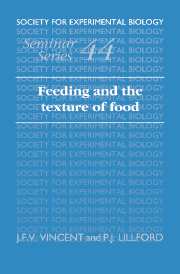Book contents
- Frontmatter
- Contents
- List of contributors
- Introduction
- Mechanical and fracture properties of cellular and fibrous materials
- Texture of plants and fruits
- Measuring meat texture and understanding its structural basis
- Food processing by mastication in cyprinid fish
- Quantitative aspects of the relationship between dentitions and diets
- The control of movements and forces during chewing
- The basic mechanics of mastication: man's adaptive success
- Integrating texture and physiology – techniques
- Brittle textures in processed foods
- The control and generation of texture in soft manufactured foods
- Texture and acceptability of human foods
- Index
Integrating texture and physiology – techniques
Published online by Cambridge University Press: 14 January 2010
- Frontmatter
- Contents
- List of contributors
- Introduction
- Mechanical and fracture properties of cellular and fibrous materials
- Texture of plants and fruits
- Measuring meat texture and understanding its structural basis
- Food processing by mastication in cyprinid fish
- Quantitative aspects of the relationship between dentitions and diets
- The control of movements and forces during chewing
- The basic mechanics of mastication: man's adaptive success
- Integrating texture and physiology – techniques
- Brittle textures in processed foods
- The control and generation of texture in soft manufactured foods
- Texture and acceptability of human foods
- Index
Summary
Texture is a fundamental sensory property of all foods, which is of great importance in determining consumer acceptability. The inability to formulate specific food textures is the major difficulty encountered in texture development and control. This results not only from a lack of fundamental knowledge of the factors that manifest themselves as texture, but also from a lack of understanding of the physiology of texture perception. Successful design of texture relies on having a means of defining and quantifying the many distinct textural attributes that foods possess. The perception of texture is a psychological response to a tactile stimulus, and therefore a full description of texture can be achieved only through the use of people.
The initial texture reaction is visual followed by the tactile reaction when the food is either cut or placed in the mouth (Peleg, 1980). The physiological reactions to food in the mouth can trigger a psychological reaction. The complexity is emphasised by Szczesniak & Kahn (1971), who described perception in the mouth as ‘a mixture of conscious and unconscious processes, the awareness being accentuated when visual expectations are violated’.
The neurological basis of oral perception involves stimulation of at least two different sensory systems. Food presents a tactile stimulus to the tongue, palate and pharyngeal regions; and chewing, through movement of both the jaw and the tongue, is the cause of muscular sensation.
Research into texture has been beset with many difficulties, misunderstandings and conflicts, which have resulted largely from the confusion surrounding terminology, and prevented rapid progress. Kramer (1955) divided the quality factors of foods into three categories: (1) appearance; (2) kinaesthetic; and (3) flavour.
- Type
- Chapter
- Information
- Feeding and the Texture of Food , pp. 167 - 184Publisher: Cambridge University PressPrint publication year: 1991
- 6
- Cited by



